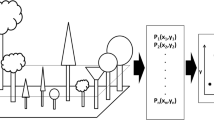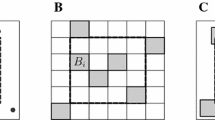Abstract
In ecology, if the considered area or space is large, the spatial distribution of individuals of a given plant species is never homogeneous; plants form different patches. The homogeneity change in space or in time (in particular, the related change-point problem) is an important research subject in mathematical statistics. In the paper, for a given data system along a straight line, two areas are considered, where the data of each area come from different discrete distributions, with unknown parameters. In the paper a method is presented for the estimation of the distribution change-point between both areas and an estimate is given for the distributions separated by the obtained change-point. The solution of this problem will be based on the maximum likelihood method. Furthermore, based on an adaptation of the well-known bootstrap resampling, a method for the estimation of the so-called change-interval is also given. The latter approach is very general, since it not only applies in the case of the maximum-likelihood estimation of the change-point, but it can be also used starting from any other change-point estimation known in the ecological literature. The proposed model is validated against typical ecological situations, providing at the same time a verification of the applied algorithms.




Similar content being viewed by others
References
Auger IE, Lawrence CE (1989) Algorithms for the optimal identification of segment neighborhoods. Bull Math Biol 51:39–54
Brodsky BE, Darkhovsky BS (1993) Nonparametric methods in change-point problems. Kluwer Academic Publishers, The Netherlands
Camarero JJ, Gutiérrez E, Fortin MJ (2000) Boundary detection in altitudinal treeline ecotones in the Spanish Central Pyrenees. Arct Antarct Alp Res 32:117–126
Cserép Sz, Standovár T, Vanicsek L (1991) Tree seedling composition as a function of site quality indicated by herbaceous species in a sessile oak stand. Vegetatio 95:71–85
Csörgő M, Horváth L (1997) Limit theorems in change-point analysis. Wiley, Chichester
Dale MRT (1999) Spatial pattern analysis in plant ecology. Cambridge University Press, Cambridge
Efron B, Tibshirani R (1993) An introduction to the bootstrap. Chapman & Hall, New York
Fagan WF, Fortin MJ, Soykan C (2003) Integrating edge detection and dynamics modelling in quantitative analyses of ecological boundaries. Bioscience 53:730–738
Fearnhead P (2006) Exact and efficient Bayesian inference for multiple changepoint problems. Stat Comput 16(2):203–213
Ferger D (1993) Asymptotic distribution theory of change-point estimators and confidence intervals based on bootstrap approximation. Math Methods Stat 3(4):362–378
Fortin MJ, Olson RJ, Ferson S, Iverson I, Hunsaker C, Edwards G, Levine D, Butera K, Klemas V (2000) Issues related to the detection of boundaries. Landscape Ecol 15:453–466
Hawkins DM (2001) Fitting multiple change-point models to data. Comput Stat Data Anal 37(3):323–341
Humboldt A (1805) Essai sur la géographie des plantes. Levrault, Schoell et Cie, Paris
Hušková M (2004) Permutation principle and bootstrap in change-point analysis. Fields Inst Commun 44:273–291
Hušková M, Kirch C (2008) Bootstrapping confidence intervals for the change-point of time series. J Time Ser Anal 29(6):947–972
Körmöczi L (2004) On the sensitivity and significance test of vegetation boundary detection. Community Ecol 6(1):75–81
Laurance WF, Didham RK, Power MF (2001) Ecological boundaries: a search for synthesis. TREE 16:70–71
Lavielle M (2005) Using penalized contrasts for the change-point problem. Signal Process 85(8):1501–1510
Lebarbier E (2005) Detecting multiple change-points in the mean of Gaussian process by model selection. Signal Process 85(4):717–736
McIntosh RP (ed) (1978) Phytosociology. Dowden, Hutchinson, and Ross, Stroudsburg, Pennsylvania
Podani J (2000) Introduction to the exploration of multivariate biological data. Bacchus Publishers, Leiden
Schwarz G (1978) Estimating the dimension of a model. Ann Stat 6:461–464
Standovár T (1988) Vegetation pattern in a sessile oak (Quercus petraea) stand. Abstr Bot 12:189–206
Standovár T, Rajkai K (1994) Herbs as soil moisture indicators within a sessile oak stand. Abstr Bot 18(2):71–78
Standovár T, Somogyi Z (1998) Corresponding patterns of site quality, decline and tree growth in a sessile oak stand. Eur J Forest Pathol 28:133–144
Stayred DI, Power ME, Fagan WF, Pickett STA, Belnap J (2003) A classification of ecological boundaries. Bioscience 53:723–729
Watt AS (1947) Pattern and process in the plant community. J Ecol 35:1–22
Worsley KJ (1986) Confidence regions and tests for a change-point in a sequence of exponential family random variables. Biometrika 73(1):91–104
Zack S (1983) Survey of classical and Bayesian approach to the change-point problem: fixed sample and sequential procedures of testing and estimation. In: Rizvi MH, Rustagi S, Siegmund S (eds) Recent advances in statistics. Academic Press, New York, pp 245–269
Zalatnai M, Körmöczi L (2004) Fine-scale pattern of the boundary zone in alkaline grassland communities. Community Ecol 5(2):235–246
Zhang NR, Siegmund DO (2007) A modified Bayes information criterion with applications to the analysis of comparative genomic hybridization data. Biometrics 63:22–32
Acknowledgments
The authors are grateful to the anonymous referees for all their suggestions to improve the paper. The authors also wish to thank the Ministry of Education and Science of Spain, which has partially supported this research (project No: TIN2007-67418-C03-02). In the initial phase if this research József Garay and Tibor Standovár were grantees of the János Bolyai Scholarship.
Author information
Authors and Affiliations
Corresponding author
Appendix
Appendix
1.1 Algorithm 1 (Estimation of the Change-Point K)
-
1.
Introduce sample X. N := Size (X).
-
2.
FOR K = 1 until N − 1:
-
(a)
Calculate: \( \overset{\lower0.5em\hbox{$\smash{\scriptscriptstyle\frown}$}}{p}_{K,i} \) and \( \overset{\lower0.5em\hbox{$\smash{\scriptscriptstyle\frown}$}}{q}_{K,i} \;, \) for each i.
-
(b)
Calculate: \( Log\;P_{K} = \sum\limits_{i = 1}^{K} {Log\;\overset{\lower0.5em\hbox{$\smash{\scriptscriptstyle\frown}$}}{p}_{{K,x_{i} }} } + \sum\limits_{s = K + 1}^{N} {Log\;\overset{\lower0.5em\hbox{$\smash{\scriptscriptstyle\frown}$}}{q}_{{K,x_{s} }} } . \) (Logarithm is introduced to avoid too small probability values.)
-
(a)
-
3.
LogProbSample: = (Log P 1,…, Log P N − 1).
-
4.
EstimateK := Position K with maximum value among the coordinates of LogProbSample.
-
5.
Return Estimate K.
1.2 Algorithm 2 (Estimation of the Change-Interval for K)
-
1.
Introduce the sample X := (x 1, x 2,…, x N ). N := Size (X).
-
2.
FOR K = 1 until N − 1
-
(a)
Calculate a weight for each K:
$$ W_{K} = \left( {\prod\limits_{i = 1}^{K} {10\overset{\lower0.5em\hbox{$\smash{\scriptscriptstyle\frown}$}}{p}_{{K,x_{i} }} } } \right)\left( {\prod\limits_{s = K + 1}^{N} {10\overset{\lower0.5em\hbox{$\smash{\scriptscriptstyle\frown}$}}{q}_{{K,x_{s} }} } } \right) $$ -
(b)
Normalize the weights (and denote them by WN K ).
-
(c)
FOR L = 1 until m (we generate m samples for each K to estimate its change-point):
-
(c1)
We draw random samples with replacement from both “homogenous” zones of the original sample separately (using “sample” function of the program “R”):

-
(c2)
We apply Algorithm 1 to the sample X L , to obtain an estimate K L for the change-point.
-
(c1)
-
(d)
From the obtained values K 1,…, K m , (m large enough) we calculate a distribution d k of the change-point, for each fixed K.
-
(a)
-
3.
We combine all these new distributions to obtain a unique distribution \( \sum\limits_{K} {WN_{K} d_{K} } \) for K, for which we calculate the 90%-level change-interval, with percentile 5 and percentile 95 as extremes.
Rights and permissions
About this article
Cite this article
López, I., Gámez, M., Garay, J. et al. Application of Change-Point Problem to the Detection of Plant Patches. Acta Biotheor 58, 51–63 (2010). https://doi.org/10.1007/s10441-009-9093-x
Received:
Accepted:
Published:
Issue Date:
DOI: https://doi.org/10.1007/s10441-009-9093-x





